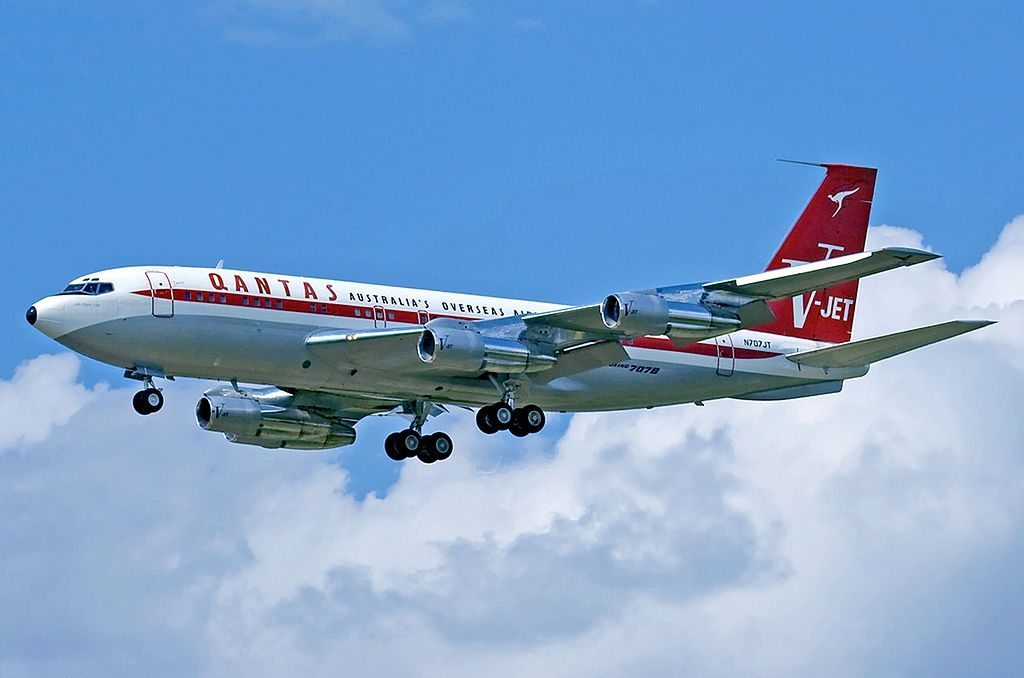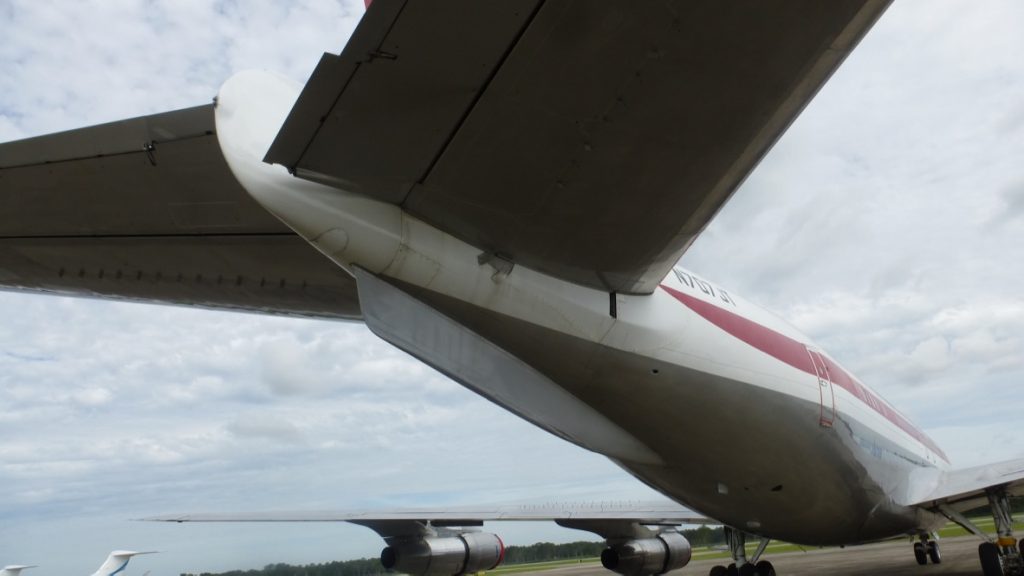
John Travolta has donated his ” beloved 707″ to HARS. Saves us having to paint it in Qantas colours I guess …. BUT .. what is so significant about this aircraft? Well, it is not JUST a Boeing 707. It is a special model built only for Qantas right at the start of the jet age. It represents the time Qantas and Australian aviation made the jump from radial-engined propeller aircraft into jets and allowed us to shrink the World.
Some Potted History
In the mid-50’s, there were two jet transports you could order. The Boeing 707 (which had yet to fly) and the De Havilland Comet. Unfortunately for the Comet it had recently had some spectacular disasters, and it was smaller and slower than an airline like Qantas wanted. The first 707 model, the “120” series flew in 1957, with its empty weight being almost that of the maximum takeoff weight of the Comet, and considerably faster.
I should inject a story about the Comet sales flight to Sydney, to show how times have changed. On its first approach to Sydney airport, the Comet 4 (which was a fine aeroplane) had to conduct a missed approach. The reason? There were too many people on the runway.
1958 and Qantas became the first foreign customer order for the 707, with customer number “38”, hence the designation 707-138. One twist though is that the aircraft was shortened by 10 feet to lower its empty weight to improve airfield performance and enable greater range .. sort of an “SP” 707. The result was that we had a 707 with the standard takeoff weight of 247,000 lb and the “civilian” J-57 (JT3C) engines producing 13,000 lb of thrust (and a long black smoke trail). Boeing built 13 of these aircraft for Qantas special requirements – to operate out of shorter airfields such as Nadi in Fiji and carry a good payload to Honolulu. As such, it was shorter with a lighter empty weight..
Now, if you know much about aircraft, you know that a special order and configuration like that are very expensive – how could Boeing do a special batch of 13 like that while avoiding expensive development costs? As it turned out, they already had a very similar aircraft in production – the Boeing 717 which we know as the KC-135 tanker. The KC-135 is all but identical in configuration to the -138 series they wanted to build, just a couple of inches narrower fuselage. So with minor modifications, they were effectively able to use the KC-135 development to build the Qantas batch.
This was the time of rapid advances in engine technology and very shortly the JT3D-3 turbofan derivatives that were far more powerful and fuel efficient became available and so were fitted to the Qantas fleet. Suddenly the installed thrust per engine became 18,000 lb and the takeoff weight went up by a modest 10,000 lb. So we have a huge thrust increase. Installed thrust of 72,000 lb and 257,000 lb takeoff weight. By comparison, the later 707 aircraft had an installed thrust of 76,000 lb and a takeoff weight of 333,000 lb. Is it any wonder the -138B version was referred to as “the hotrod”. After re-engining, the aircraft could fly direct Honolulu – Sydney when only a few years previously with piston aircraft, stops at both Canton and Nadi were needed.
Of the thirteen produced, the first is at the Qantas Founders’ Museum in Longreach, there appears to be one other still flying in Africa and then there is the last one, coming home and a neat “bookend” to this chapter of history. You can have a look at these by visiting http://www.aussieairliners.org/b-707q/707index.html . Aussieairliners is a website associated with HARS and has an extensive database of airliners.
Comparing the two aircraft – VH-XBA at the Qantas Founders’ Museum and the Hars aircraft, XBA spent six years parked in the English weather before restoration work started. Rumour has it that the dedicated group of volunteers were regarded with some amusement by locals at the start of their project. And then the engine runs started and the amusement started to dissipate until finally the test flights and departure.
The Hars aircraft, (former “VH-EBM” ) has had a relatively easy life compared to many other airliners. Even after he donated it and it was parked, John Travolta made sure his “beloved 707” was still cared for before maintenance commenced by having an engineering team visit it each month. After one visit by our engineering assessment team, the comment heard from one of the team was “we felt as if we could just refuel it and fly it home”.
138 and 138B differences
You can see the difference between the two in the supplied photographs – the paint scheme was changed for the new engine and “V-jet” introduced. You can also see there is a ventral fin under the rudder introduced with the fan engines – which it would appear was introduced to assist with engine-out stability (higher thrust engines would have meant higher Vmca/g issues), though that is an educated guess.


Early Boeing Jet Airliner Development
It is easy to get confused by the early Boeing jet airliner development. Especially when there is so much false information out there – as an example the claim that Tex Johnson barrel-rolled a 707. That claim is untrue as it was NOT a 707 he did that to but the technology demonstrator the 367-80.
When Boeing decided to build a jet airliner, they did not want to let their competitors know, so they used the model number of a current airliner and added the “-80” moniker to mis-lead. They used the -80 as a demonstrator and to prove various technologies for a subsequent airliner design. To name the new series of Jet transports, they decided to use a “7” series, and the name “707” had a nice ring to it.
In the meantime though, the USAF had a need for jet tankers to refuel their B-47 and B-52 bombers and so that became a priority (well, a multi-hundred aircraft order one would think it was a priority). Consequently the tanker design was done first, and this would also help them refine what was needed for their airliner. The “707” model number was already taken so they used “717” for the tankers. This was a developed version of the -80 with, amongst other things, lengthened and larger diameter fuselage.
With the initial experience from the 717 / KC-135, Boeing completed the 707 design, further lengthening and increasing the diameter of the fuselage.
Now it gets complicated and messy. For the Qantas order, they used the development data from the KC-135 to shorten the 707 fuselage. From that they thought the -138 would be a good basis for a shorter range domestic transport and so the 720 was born. For a little while they wanted to market it as a 717-020, but soon dropped the idea and simply called it a “720”, their domestic aircraft until the Boeing 727 came along.
Way down the track when Boeing took over McDonnell-Douglas, they wanted to integrate the MD-95 into the Boeing family and since they had never officially used the “717” term in marketing, they called it the 717. It would be interesting what they printed on the manufacturer’s plate – I’m thinking MD-95.
So there we have a horribly convoluted tale of how it all was. I commend the appropriate Wikipedia pages for you further reading.
Finally, remember that even though the 717/KC-135 and 707/C-137 look very similar there are significant differences in fuselage diameter, structure, crew requirements and systems.
Image: Wikicommons: Phinalanji
